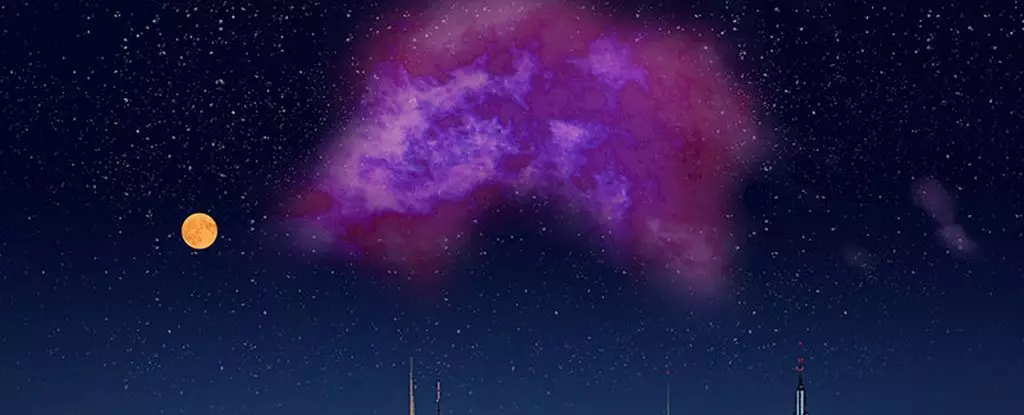In a groundbreaking revelation, astronomers have recently uncovered a massive crescent-shaped cloud of molecular hydrogen, dubbed “Eos,” just 300 light-years from our Solar System. This colossal structure, contributing to the invisible fabric of our universe, symbolizes a profound leap in our capacity to detect and understand the complex phenomena within interstellar space. The discovery illuminates not just the physical dimensions of this molecular cloud, but also nurtures an evolving narrative about the genesis of stars and cosmic elements that compose our reality.
The discovery of Eos marks a crucial moment in astrophysical research, utilizing far-ultraviolet (FUV) light to uncover celestial bodies that previously eluded direct observation. This innovative approach allows scientists to directly observe molecular hydrogen through its fluorescence—a process that is drastically different from previous methods, which often relied on the presence of carbon monoxide as a tracery of interstellar material. The pursuit of such elusive matter is not merely academic; it represents a crucial step toward unlocking insights into the very mechanics of stellar formation and the life cycles of galaxies.
A Hidden Universe of Molecular Hydrogen
Commonly perceived as an apparent void with isolated pinpricks of light, interstellar space is, in fact, a rich tapestry of material—most of which remains undetected. This unmasking of Eos challenges our long-standing perceptions of the cosmos, compelling scientists and enthusiasts alike to reconsider the fabric of what we perceive as ’empty’ space. The immense molecular cloud—stretching across an estimated 80 to 85 light-years—comprises roughly 2,000 solar masses worth of hydrogen, accentuating its colossal scale and significance within the galactic framework.
The ingenuity of this scientific pursuit lies in recognizing that while the stars punctuate the night sky with their brilliance, the surrounding molecular clouds could be quietly facilitating their existence. The thin veil of molecular hydrogen not only signifies the genesis of new stars, but it also provides us with clues about the interstellar medium and its interactions with various stellar phenomena. By bridging the knowledge gap on these clouds, Eos catalyzes a deeper understanding of galactic dynamics.
Methods of Detection: Shifting the Paradigm
Astrophysicist Blakesley Burkhart and her team employed an unorthodox trick of the trade for detecting Eos, shifting away from conventional methodologies reliant on carbon house. By analyzing data retrieved from South Korea’s STSat-1 ultraviolet space telescope, they redirected the gaze of astronomy toward the far-ultraviolet emissions of molecular hydrogen. This innovative technique could revolutionize our approach to hunting for molecular clouds both within and beyond our galaxy.
The implications of this method extend far beyond the confines of Eos; it stimulates an unparalleled inquiry into the invisible entities that populate our universe. For too long, molecular clouds have evaded thorough investigation, often attributed to their low-density and dim emissions. The bold exploration of Eos serves as a beacon of hope for unveiling a myriad of similar structures lurking throughout the cosmos, waiting to be illuminated by groundbreaking detection methods.
The Fate of Eos: Temporal Dynamics and Cosmic Processes
While the discovery of Eos heralds a new chapter in astrophysical research, it is imperative to contemplate its transient nature. Photodissociation, the process by which hydrogen molecules are eroded by neighboring stars, suggests that Eos is not a permanent fixture in our cosmic neighborhood. At a rate of approximately 600 solar masses lost per million years, its eventual dissipation into the void signifies the impermanence of even the most grand cosmic structures.
Understanding the life cycle of Eos provides profound repercussions for researchers monitoring star formation and the evolution of galaxies. The knowledge gleaned from Eos can not only enhance our grasp of the fundamental processes shaping the universe but also influence predictions regarding future cycles of star birth and death across vast time scales. Such realizations underline the fragility and dynamism of molecular clouds—imbuing them with a sense of urgency as scientists strive to map the intricate mechanics of the interstellar medium.
A Journey into the Cosmos
Eos’s discovery opens the door to a wealth of knowledge regarding the universe’s formative stages. Each star and planet’s journey begins in the murky depths of molecular clouds, and the illumination of Eos offers a unique opportunity for direct study. By harnessing new methods of detection, scientists now can chart the transition of interstellar gas into the foundations of stellar systems. The hope is that revelations from Eos will contribute to our collective understanding of the history and evolution of the Milky Way and its ongoing narrative in the grand cosmic story.
As astronomers gaze into the depths of the cosmos, Eos stands as a testament to the unending curiosity that drives exploration. The universe, replete with hidden wonders, promises countless mysteries—each waiting to be unveiled by the relentless pursuit of knowledge that characterizes human endeavor. In recognizing and celebrating groundbreaking discoveries like Eos, we imbue ourselves with the inspiration to unravel the next layer of our cosmic existence.

